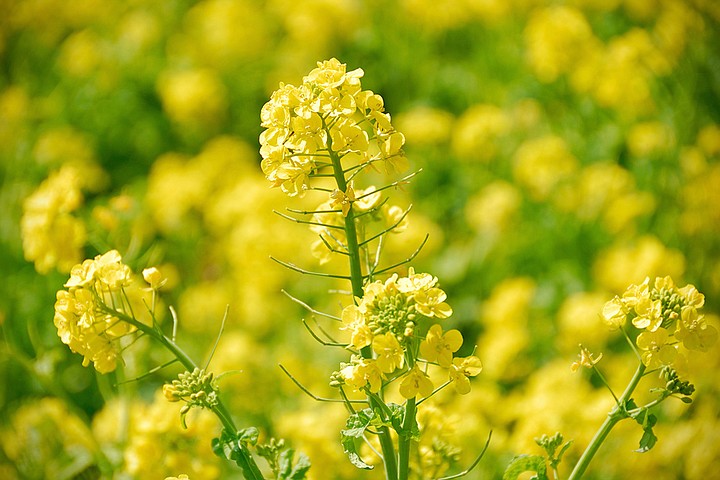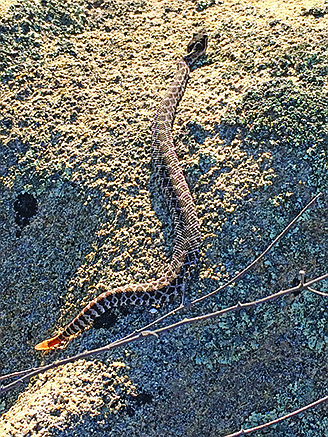 Facebook
Facebook
 X
X
 Instagram
Instagram
 TikTok
TikTok
 Youtube
Youtube

Mustard, a nonnative plant more like a weed than a wildflower, is blooming profusely on grassy slopes all along the coastline of San Diego County. An old story, probably apocryphal, tells of the padres scattering mustard seed along the El Camino Real so that the bright, yellow mustard blossoms would help them find their way in future spring seasons. More likely, the plant was introduced to western North America in the form of seeds carried in the hay used to feed livestock brought in by the early settlers.

Fremont Cottonwoods along the San Diego River in Mission Gorge will show off their best iridescent green foliage this month. The Old Mission Dam parking area on Father Juñipero Serra Trail, off Mission Gorge Road (west of Santee), is a good place to begin a stroll on trails near the riverbed. Be careful — rattlesnakes may be out and about this time of year.
The Tall Locust Trees planted years ago along Julian's narrow streets are once again brightening this backcountry (and former gold-rush) town with blossoms of white, pink, and lavender. Introduced into the West by 19th century emigrants, locust trees have become almost a trademark of California's gold country, from the Mother Lode south to Julian.

The Black Oak, San Diego County's most handsome native deciduous tree, is sending out new leaves this week, painting the mountain slopes with shades of red, brown, and bright green. The newly emergent leaves are reddish brown in color, creating a pseudo-autumn color in the forest. After a week or two the unfolding leaves acquire a light green tint; after a month they're dark green. Black oaks are commonly found in the upper elevations of the county in areas such as the Palomar, Cuyamaca, and Laguna mountains.
Snakes, encouraged by recent warm temperatures, have already emerged from burrows and rock crevices to hunt for prey throughout the county's lower elevation hillsides and canyons. Gopher snakes, garter snakes, king snakes, rosy boas (all harmless), and three varieties of rattlesnakes — red diamond, speckled, and Southern Pacific rattlesnakes (all poisonous) — have been sighted. Close encounters with rattlesnakes are not uncommon wherever residential properties abut undeveloped land — a common situation throughout San Diego County.
The above comes from the Outdoors listings in the Reader compiled by Jerry Schad, author of Afoot & Afield in San Diego County. Schad died in 2011. Planet information from SkyandTelescope.org.


Mustard, a nonnative plant more like a weed than a wildflower, is blooming profusely on grassy slopes all along the coastline of San Diego County. An old story, probably apocryphal, tells of the padres scattering mustard seed along the El Camino Real so that the bright, yellow mustard blossoms would help them find their way in future spring seasons. More likely, the plant was introduced to western North America in the form of seeds carried in the hay used to feed livestock brought in by the early settlers.

Fremont Cottonwoods along the San Diego River in Mission Gorge will show off their best iridescent green foliage this month. The Old Mission Dam parking area on Father Juñipero Serra Trail, off Mission Gorge Road (west of Santee), is a good place to begin a stroll on trails near the riverbed. Be careful — rattlesnakes may be out and about this time of year.
The Tall Locust Trees planted years ago along Julian's narrow streets are once again brightening this backcountry (and former gold-rush) town with blossoms of white, pink, and lavender. Introduced into the West by 19th century emigrants, locust trees have become almost a trademark of California's gold country, from the Mother Lode south to Julian.

The Black Oak, San Diego County's most handsome native deciduous tree, is sending out new leaves this week, painting the mountain slopes with shades of red, brown, and bright green. The newly emergent leaves are reddish brown in color, creating a pseudo-autumn color in the forest. After a week or two the unfolding leaves acquire a light green tint; after a month they're dark green. Black oaks are commonly found in the upper elevations of the county in areas such as the Palomar, Cuyamaca, and Laguna mountains.
Snakes, encouraged by recent warm temperatures, have already emerged from burrows and rock crevices to hunt for prey throughout the county's lower elevation hillsides and canyons. Gopher snakes, garter snakes, king snakes, rosy boas (all harmless), and three varieties of rattlesnakes — red diamond, speckled, and Southern Pacific rattlesnakes (all poisonous) — have been sighted. Close encounters with rattlesnakes are not uncommon wherever residential properties abut undeveloped land — a common situation throughout San Diego County.
The above comes from the Outdoors listings in the Reader compiled by Jerry Schad, author of Afoot & Afield in San Diego County. Schad died in 2011. Planet information from SkyandTelescope.org.
Comments